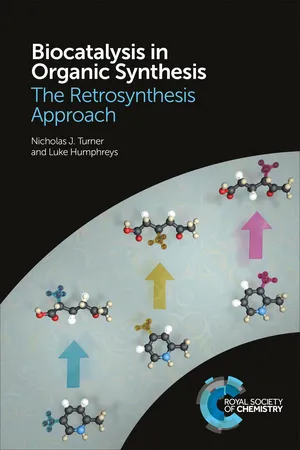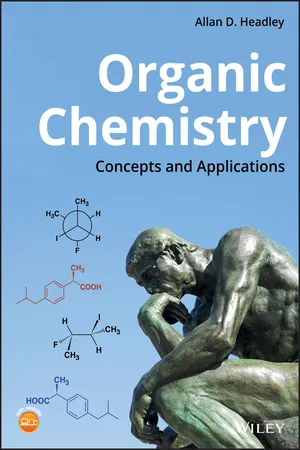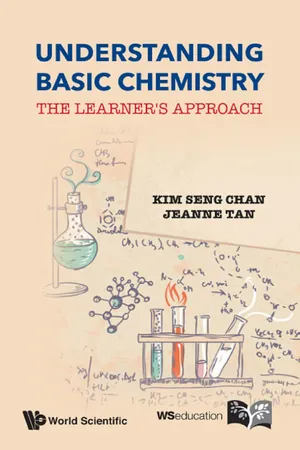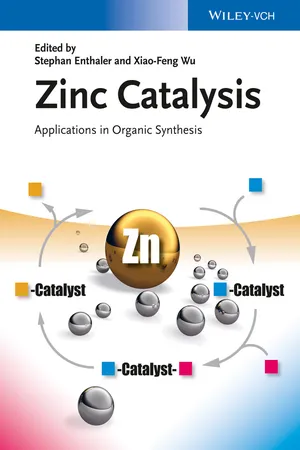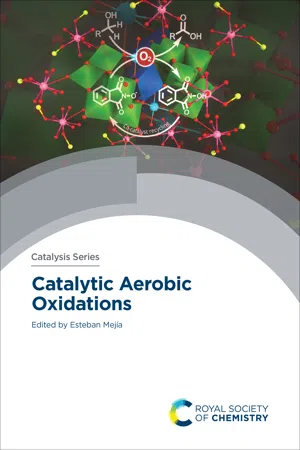Chemistry
Oxidation of Alkanes
Oxidation of alkanes involves the reaction of alkanes with oxygen or other oxidizing agents to form products such as alcohols, aldehydes, or carboxylic acids. This process typically requires the presence of a catalyst and can be used to produce valuable chemical intermediates. Oxidation of alkanes is an important transformation in organic chemistry with various industrial applications.
Written by Perlego with AI-assistance
Related key terms
Related key terms
1 of 4
Related key terms
1 of 3
8 Key excerpts on "Oxidation of Alkanes"
- eBook - ePub
- Armando J. L. Pombeiro, Maria de Fatima Costa Guedes da Silva, Armando J. L. Pombeiro, Maria de Fatima Costa Guedes da Silva(Authors)
- 2018(Publication Date)
- Wiley(Publisher)
2 Activation and Oxidative Functionalization of Alkanes with Noble‐Metal Catalysts: Molecular MechanismsEvgeniy G. ChepaikinInstitute of Structural Macrokinetics and Materials Science, Russian Academy of Sciences, Chernogolovka, Moscow, Russia2.1 Introduction
Industrial‐scale production of alcohols, aldehydes, ketones, carboxylic acids, and other products of organic and oil‐and‐gas synthesis via oxidation of lower alkanes (C1 –C4 ) still remains to be in focus of current studies in the field of catalysis. It has been multiply declared that the oxidation of methane into methanol with dioxygen is a great challenge or even the Holy Grail of modern chemistry. The gas‐phase oxidation of methane over heterogeneous catalysts has shown low selectivity since it is accompanied by transformation of methane into carbon dioxide at elevated temperatures required by the process [1 , 2 ]. In this context, great expectations are associated with homogeneous catalysis that is operative in much milder conditions. The reactions proceeding by molecular mechanisms exhibit higher selectivity than radical and chain‐radical reactions.In 1965, Chatt and Davidson [3] reported on oxidative addition of naphthalene to Ru complex with 1,2‐(dimethylphosphino)ethane. Later, Halpern [4] declared the exceeding importance of the activation of the C H bond in alkanes as for their involvement into selective catalytic reactions in mild conditions. Shilov and co‐workers [5] were the first who carried out such a process in laboratory. To date, the examples of C H bond activation in alkanes are numerous. Meanwhile, it has become clear that a much more difficult problem is the functionalization of an activated C H bond.A number of monographs [6 –15 ] and vast amounts of reviews and original papers have been devoted to the activation of alkanes and dioxygen and also to Oxidation of Alkanes and other substrates, including special issues of leading journals such as Chem. Rev. 2010, vol. 110, no. 2; J. Organomet. Chem. 2015, vol. 793; and J. Mol. Catal. A: Chem. 2017, vol. 426. Worth mentioning are excellent reviews [16 –31 ]. The author of this chapter has also published three review papers [32 –34 - eBook - ePub
Biocatalysis in Organic Synthesis
The Retrosynthesis Approach
- Nicholas J Turner, Luke Humphreys(Authors)
- 2018(Publication Date)
- Royal Society of Chemistry(Publisher)
Alkanes are saturated hydrocarbons, which makes them the lowest oxidation level of carbon atoms. They are highly important molecules, forming the basis of the chemical industry itself. They can be obtained from natural resources such as gas and crude oil and are also found in algae, bacteria and plants. They are used as a fuel to produce energy and converted into alkenes, which in turn are raw materials for products such as polymers, adhesives and detergents, as well as chemical synthesis. Chiral alcohols, formed by the Oxidation of Alkanes, are also valuable and are precursors for compounds used in agrochemicals, pharmaceuticals or liquid crystals. This makes the selective Oxidation of Alkanes to alcohols an important reaction for chemical synthesis. However, this reaction is challenging as carbon–hydrogen bonds are relatively inert with high activation energy, and for a substrate with many C–H bonds, obtaining high chemo-, regio- and stereoselectivity is a problem. In addition, the product alcohols are more easily oxidised than the starting material, so these reactions are difficult to control. In addition to chemical approaches, enzymes have been reported to catalyse the selective Oxidation of Alkanes to alcohols. These methods use mild conditions and green solvents, and the products can be obtained with high chemo-, regio- or stereoselectivity. In the next two sections, we will look at families of enzymes that are capable of performing these reactions.6.2.1 Oxidation of Alkanes with P450 Monooxygenases
One of the families of enzymes capable of catalysing the hydroxylation of alkanes is the P450 monooxygenases. As shown in Figure 6.2 , these enzymes use molecular oxygen and two electrons from a nicotinamide co-factor, which is the terminal reductant to carry out the hydroxylation.Figure 6.2 General transformation of alkane oxidation catalysed by P450 monooxygenases.There are many methods of producing alcohols, some of which are detailed in Figure 6.3 - J. Grimshaw(Author)
- 2000(Publication Date)
- Elsevier Science(Publisher)
CHAPTER 2Oxidation of Alkanes, HALOALKANES AND ALKENES
Radical-Cations
Oxidation of Alkanes involves the removal of an electron from either a carbon-hydrogen or a carbon-carbon σ-bond. These are dissociative processes where the radical-cation cannot be detected as an intermediate in either fluorosulphuric acid or acetonitrile.Oxidation of iodoalkanes involves removal of an electron from the halogen non-bonding orbital. The radical-cations of primary and secondary alkyl iodides can be identified in aqueous solution by their absorption spectra and have half-lives of microseconds [1 ]. They are formed during pulse radiolysis of the iodoalkane in aqueous solution in the presence of nitrous oxide. This system generates hydroxyl radicals, which remove an electron from the iodine atom lone pair. Iodoalkane radical-anions complex with the lone-pair on other heteroatoms to form a 2σ/1σ* three-electron bond. In aqueous solution, the radical-cation of iodomethane is involved in an equlibrium indicated by Equation 2.1 .Eq. 2.1Related three-electron bond radical-cations 1 are formed from dialkyl sulphides by oxidation with hydroxyl radicals generated using pulse radiolysis [2 ]. An isoelectronic three-electron bond between two nitrogen atoms in 2 is formed by reductionof the hydrazine dication with sodium in liquid ammonia. This species is sufficiently stable to be sublimed in vacuum as the tetrafluoroborate salt [3 ].Electrochemical oxidation of alkenes results in the removal on one electron from the alkene function to give a π-radical-cation where the electron deficiency is delocalised over the conjugated system. The majority of alkene radical-cations cannot be characterised because they readily lose an allylic proton in aprotic solventsor react with any nucleophile present in solution. Important exceptions are the radical-cations of the rigid adamantane derivatives 3 and 4- eBook - ePub
Organic Chemistry
Concepts and Applications
- Allan D. Headley(Author)
- 2019(Publication Date)
- Wiley(Publisher)
11 Oxidation Reactions in Organic Chemistry11.1 Introduction
Oxidation is the opposite of reduction, which was covered in the previous chapter. Oxidation involves the removal of electrons and or hydrogen atoms and the supply of oxygen to another molecule. Oxidation reactions are very important reactions in organic chemistry, and many of these reactions are used in synthetic organic chemistry to transform the functionalities of molecules into other functionalities. Oxidation reactions are also important in that the combustion of some compounds releases large amounts of energy in the form of heat. Before we proceed, however, we need to be able to identify oxidizing agents. One of the easiest oxidizing agents to recognize is oxygen. We are all familiar with rust, which is a form of oxidation, in which oxygen oxidizes metals. There are other oxidizing agents, and most that are used in organic chemistry typically contain a number of oxygen atoms. Two common oxidizing agents of organic chemistry are shown below.We will see in this chapter that these oxidizing agents are some of the strongest oxidizing agents of organic chemistry, and sometimes salts of chromic acid are used in combination with sulfuric acid to make an even stronger oxidizing agent. In this chapter, we will apply the concept of oxidation to a number of different types of functional groups to obtain molecules with different functionalities. We will also utilize a combination of various reaction types, including oxidation reaction, to strategically synthesize new target molecules.11.2 Oxidation
Combustion is the reaction of compounds with oxygen under suitable reaction conditions. Reaction (11‐1) shows the combustion of methane, and Reaction (11‐2) shows the combustion of butane.(11‐1)(11‐2)Complete combustion of alkanes yields carbon dioxide and water as the products. These reactions are very important, during the winter, and the combustion of natural gas is used to heat our homes, classrooms, and workplaces. Natural gas is 60–90% (methane) and the other 10–40% consists of C2 H6 and C3 H8 , N2 , CO2 - eBook - ePub
Understanding Basic Chemistry
The Learner's Approach
- Kim Seng Chan, Jeanne Tan(Authors)
- 2014(Publication Date)
- WSPC(Publisher)
QIt is said that combustion of an alkane is actually a redox process. How can we prove it?A:If you count the oxidation number of the C atom in ethane, each has a oxidation number of –3. This oxidation number is derived if we consider that C atom is slightly more electronegative than a H atom; as a result with three C−H bonds, the C atom would have a −3 oxidation state. Next, the oxidation number of the C atom in CO2 is +4. Therefore, combustion of an alkane to CO2 is a redox reaction.QWhy is combustion of an alkane exothermic? And why with more carbon atoms present in an alkane molecule, the more exothermic would the combustion be?A:You can use bond energies data to prove this. Essentially, the energy that is released during the formation of the strong bonds in CO2 and H2 O is much more than the energy that is required to break the C−H, C−C, and O=O bonds. Hence, you have an exothermic reaction.However, if the supply of oxygen is limited, incomplete combustion occurs and products such as non-combusted carbon (in the form of soot) and CO are formed apart from CO2 and H2 O, i.e.,Substitution reactionAlkanes, although unreactive with seemingly few reactions, do undergo substitution with halogens (Cl2 or Br2 ), but only in the presence of stringent conditions such as strong heating and ultraviolet (UV) light. Each hydrogen atom in ethane can be substituted by a bromine atom.If all the hydrogen atoms are replaced, the product formed is as follows:15.3 AlkenesAlkenes are unsaturated hydrocarbons containing the C=C double bond, which is the functional group in alkene. They have the general formula CnH2n - eBook - ePub
Zinc Catalysis
Applications in Organic Synthesis
- Stephan Enthaler, Xiao-Feng Wu, Stephan Enthaler, Xiao-Feng Wu(Authors)
- 2015(Publication Date)
- Wiley-VCH(Publisher)
3 Zinc-Catalyzed Oxidation Reactions Liang-Qiu Lu and Xiao-Feng Wu 3.1 Introduction Oxidation reactions are fundamentally important transformations in organic chemistry [1]. In general, during these processes, the oxidation states of specific atoms in the organic molecules change and a transfer of electrons between species is involved (Scheme 3.1). Thus, organic chemicals with low oxidation states such as bulky alkanes, alkenes, and alkynes can be transformed into many different and useful fine chemicals, which are of interest for industrial applications as well as academic research, through oxidative operations. Scheme 3.1 Catalytic oxidations of unsaturated compounds (FG = functional group). Indeed, after hundreds of developments, a countless number of oxidation reactions have been explored with various oxidants such as high-valence inorganic salts (i.e., KMnO 4, K 2 CrO 4, or K 2 S 2 O 8), and organic peroxides (i.e., tert -BuOOH, (tert -BuO) 2, or m -CPBA (meta -chloroperoxybenzoic acid)) [2]. From the viewpoint of environmental and economic considerations, catalytic oxidative technologies represent an important tool for the advancement of “green chemistry”, which means low/less waste generation and low energy consumption, as well as high atom economy and environmental friendliness [3]. To this purpose, many transition metals, especially precious metals such as ruthenium, palladium, and iridium, are applied in these transformations, due to their high catalytic performance [4]. However, considering their limited abundance on earth, high prices, and toxicity, chemists began to investigate new catalyst systems by using first-row transition metals. Currently, cheap, abundant and low-toxic metals such as zinc attract the attention of the synthetic community [5]. Unlike neighboring metals such as iron (0 to +5) and copper (0 to +3), zinc does not have rich oxidation states (non-redox metal, mainly 0 and +2) - eBook - ePub
- Esteban Mejía, Esteban Mejía(Authors)
- 2020(Publication Date)
- Royal Society of Chemistry(Publisher)
CHAPTER 9 Industrial Aerobic Oxidation of HydrocarbonsF. Cavani* and T. Tabanellia Alma Mater Studiorum Università di Bologna, Dipartimento di Chimica Industriale “Toso Montanari”, Viale Risorgimento 4, 40136 Bologna, Italy* Corresponding contributor. Email: [email protected]9.1 The Industrial Aerobic Oxidation of HydrocarbonsCatalytic oxidation accounts for the production of several organic chemicals; indeed, many processes for bulk chemical production involve the oxidation of hydrocarbons.1 – 11Table 9.1 summarizes the main industrial processes for Oxidation of Alkanes and alkenes, aimed at the synthesis of a variety of compounds, such as monomers and intermediates.12Table 9.1 Industrial processes of synthesis of bulk chemicals by means of catalytic oxidation.Oxidation process PHASE Reactor Catalyst Reactant Conv., Selectivity Reaction conditions CH4 + NH3 + ½ O2 → HCN + H2 O (ammoxidation)Pt/Rh gauzes Oxidant air GAS PHASE 100%, 80%–85% Feed: 15% O2 , 15% NH3 , 15% CH4Converter chamber T 1100–1200 °C. P 2–4 bar C2 H4 + ½ O2 → C2 H4 O (epoxidation)Ag-αAl2 O3 + dopantsOxidant O2GAS PHASE 15%–20% ppa (overall >99%), 76%–82%Feed: 7%–9% O2 , 20%–40% ethene, rest ballast (methane)Fixed-bed multi-tubular reactor T 250–270 °C. P 12–15 bar 96%–98%, 65%–70% Oxidant air Feed: 5%–8% O2 , 3%–5% ethene, rest inerts (N2 , CO2 )T 250–280 °C. P 10–20 bar C2 H4 + 2HCl + ½ O2 → 1,2-C2 H4 Cl2 + H2 O (oxychlorination)GAS PHASE Fixed-bed multitubular reactor or fluidized-bed reactorCuCl2 -γAl2 O3 + dopants (K, Mg)97%–99%, 95%–98%<40% ppa , 96%–99%97%–99%, 94%–97%Oxidant O2Feed: 24%–28% ethene, 47%–55% HCl, rest O2Oxidant O2Feed: 30%–50% ethene, 20%–30% HCl, rest O2 plus ballastOxidant airFeed: 12%–15% ethene, 8%–10% O2 , rest N2Fluidized bed: T 220–250 °C. P 3–5 bar Fixed-bed (three in-series reactors, with differentiated oxidant feed): T 230–300 °C. P 3–15 bar - eBook - ePub
DAT Prep Plus 2023-2024
2 Practice Tests + Proven Strategies + Online
- (Author)
- 2023(Publication Date)
- Kaplan Test Prep(Publisher)
N 2-type reactions. They can serve as the substrate for nucleophilic attack on the carbonyl to produce alcohols, ethers, amides, and related compounds. They can condense to form larger molecules and to create double bonds.Although the variety of aldehyde and ketone reaction pathways can appear overwhelming, studying them in the context of other organic molecules allows a greater understanding of the overall mechanisms involved.Synthesis of Aldehydes and Ketones
Oxidation of Alcohols
An aldehyde can be obtained from the oxidation of a primary alcohol; a ketone can be obtained from a secondary alcohol. These reactions are usually performed with PCC (one of the only options to create an aldehyde), potassium permanganate, sodium or potassium dichromate, or chromium trioxide (Jones reagent). These reactions are discussed in Chapter 45 .Figure 46.5Figure 46.6Oxidative Cleavage of Alkenes
Double bonds can be oxidatively cleaved with ozone to yield aldehydes and/or ketones (see Chapter 43 ).Ketones can also be synthesized by the cleavage of disubstituted alkenes with potassium permanganate:Figure 46.7Figure 46.8Friedel-Crafts Acylation
This reaction, discussed in Chapter 44 , produces ketones of the form R–CO–Ar from benzene and an acyl halide in the presence of a Lewis acid such as AlCl3 .Figure 46.9Reactions of Aldehydes and Ketones
Oxidation and Reduction
Aldehydes and ketones occupy the middle of the oxidation-reduction continuum. They are more oxidized than alcohols but less oxidized than carboxylic acids.Aldehydes can be oxidized with a number of different reagents, such as KMnO4 , K2 Cr2 O7 , CrO3 , Ag2 O (Tollen’s reagent), or H2 O2
Index pages curate the most relevant extracts from our library of academic textbooks. They’ve been created using an in-house natural language model (NLM), each adding context and meaning to key research topics.
Explore more topic indexes
Explore more topic indexes
1 of 6
Explore more topic indexes
1 of 4

